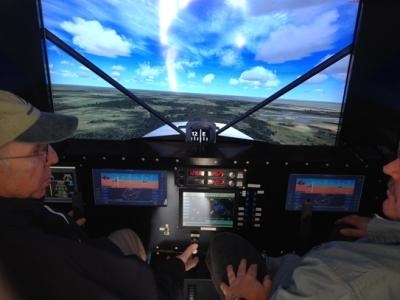Mon, Jan 28, 2013
Company Shows Off Training Device Geared To The Light Sport Market
By David Juwel
Some time ago, as a Private Pilot, I took a hiatus from actual flying. But I did spend time on my Microsoft flight simulator every week; several hours at a time. Then I happened to go up in an aircraft with a friend who is a Commercial Pilot. He let me fly his Cessna 172 for the greater part of the trip. When the flight was over, he told me he was surprised because my skill level was consistent with that of a commercial pilot. When he told me that, it surprised me too; I hadn’t flown a plane in several years. The only thing I could contribute it to was my flight simulator. It apparently helped me to keep my flight muscle memory and instrument skills alive.

The Eastern Atlantic Simulation & Education Company (EASE) out of Sanford, Florida, has come to that same conclusion; albeit on a grander scale and focused on LSA flying. Using the PS3D flight simulator software by Lockheed, they have put together a unique flight simulation system. The system is built into a 5’x5’x6’ box with a 2-place full cockpit offering all the basic aircraft controls, 200 degrees of peripheral view, photo realistic scenery, and a terrain package. It also has a 2’x2’ motion base that can be added to it which provides the simulator box with 15 degrees of pitch and roll.
EASE says their system is unique in three ways:
- The engineer can design any LSA (or Experimental) aircraft into the system. For demonstration purposes it emulated the ICP Savannah aircraft. But they could have easily put the Bristell or the CTLS into it; whichever type of aircraft the FBO is currently using with its students. So instead of training and practicing in a generic cockpit, you can train and practice in an exact performing replica of the aircraft you actually fly.
- It will enable LSA pilots to receive relatively inexpensive instrument training. Not so they can do unauthorized instrument flying in their LSA aircraft, but because they could inadvertently enter into IMC, and this inexpensive training could save their lives.
- There is an optional Air Traffic Control (ATC) module which provides realistic interaction between pilots and aircraft traffic controllers in a challenging yet controlled manner.
While actual airplanes are needed to fully develop the skills necessary to become a safe pilot, this simulator can both enhance and accelerate the learning process. You can proceed with your training whenever weather, darkness or maintenance issues prevent actual flying.You can set up the simulator with either steam gauges or digital (glass). You can add GPS, weather radar and autopilot. It can be fixed-gear (LSA) or retractable (Experimental). To give you realistic training, it can be whatever you want it to be. The company engineer is capable of customizing it to your specifications.
Interestingly, teenagers have been drawn to it too. This is because it’s a step up from what they’re flying in their home, and they really understand it. Properly presented, this could be an excellent tool to draw the youth into General “reality” Aviation.
The entire package is competitively priced at $79,000. The basic simulator system is $49,000. The motion box is $20,000. The ATC module is $10,000.
More News
Very High Frequency The frequency band between 30 and 300 MHz. Portions of this band, 108 to 118 MHz, are used for certain NAVAIDs; 118 to 136 MHz are used for civil air/ground voi>[...]
Aero Linx: Aviation Suppliers Association Established February 25, 1993, the Aviation Suppliers Association (ASA), based in Washington, D.C., is a not-for-profit association, repre>[...]
Have A Story That NEEDS To Be Featured On Aero-News? Here’s How To Submit A Story To Our Team Some of the greatest new stories ANN has ever covered have been submitted by our>[...]
From 2021 (YouTube Version): Colorado Campus Offers aVariety Of Aerospace Entertainment And Education Wings over the Rockies Exploration of Flight is the second location for the Wi>[...]
Also: Paramotor Champ's, Electric Ultralight, ICON BK Update, Burt Rutan at Oshkosh! The Popular Rotorcraft Association is reaching out for help in rebuilding their private runway >[...]
 ANN's Daily Aero-Term (05.17.24): Very High Frequency
ANN's Daily Aero-Term (05.17.24): Very High Frequency ANN's Daily Aero-Linx (05.17.24)
ANN's Daily Aero-Linx (05.17.24) ANN FAQ: Submit a News Story!
ANN FAQ: Submit a News Story! Classic Aero-TV: ANN Visits Wings Over The Rockies Exploration Of Flight
Classic Aero-TV: ANN Visits Wings Over The Rockies Exploration Of Flight Airborne Affordable Flyers 05.16.24: PRA Runway, Wag-Aero Sold, Young Eagles
Airborne Affordable Flyers 05.16.24: PRA Runway, Wag-Aero Sold, Young Eagles



